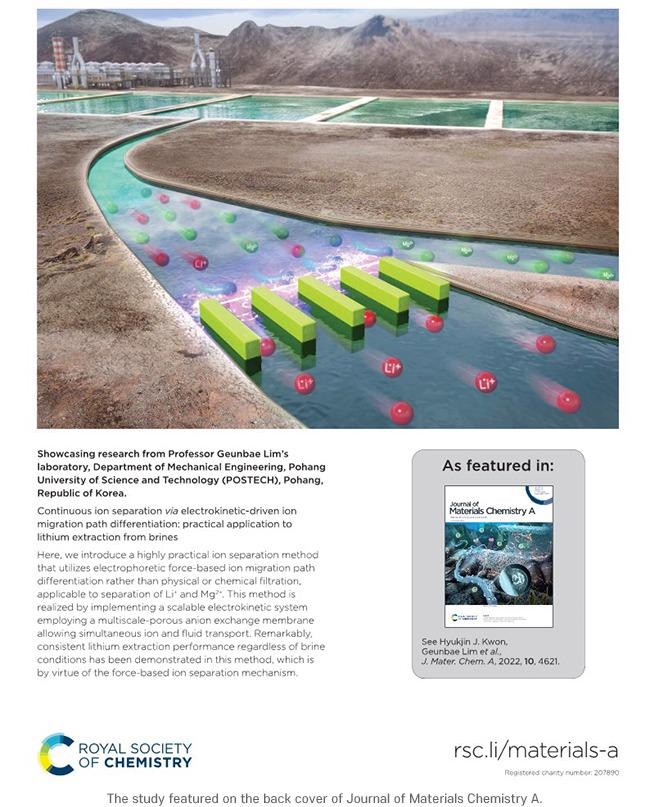Climate warming and the looming depletion of fossil resources are driving up demand for electric automobiles. The price of lithium, which is required to power electric vehicles, is also rising as a result of the rising demand. Evaporation or filtration procedures are used to extract lithium from salt lake brines—however, a considerable proportion of magnesium dissolved in the brine has made lithium mining difficult.
 The study featured on the back cover of Journal of Materials Chemistry A. Image Credit: Pohang University of Science and Technology.
The study featured on the back cover of Journal of Materials Chemistry A. Image Credit: Pohang University of Science and Technology.
Professor Geunbae Lim, Ph.D. candidate Minsoo Lee, and Dr. Hyukjin J. Kwon (Department of Mechanical Engineering) of POSTECH recently developed a novel filterless and electrokinetic-driven ion separation system for lithium and magnesium without the need for any extractants in collaboration with Dr. Woochul Jung of Research Institute of Industrial Science and Technology (RIST).
The findings of the study were featured on the back cover of Journal of Materials Chemistry A, an international journal dedicated to materials science.
Magnesium forms a complex with lithium during solar evaporation and co-precipitates during the chemical precipitation method, resulting in a double loss of lithium when recovering lithium from salt lake brines. As a result, when the quantity of magnesium in the brine rises, the proportion of lithium lost and the cost of extraction rises dramatically.
Over the years, a variety of solutions have been offered to address this issue, but the process of extracting, which relies on physical or chemical filtration, has restricted their scalability and application.
The scientists have focused on the electrokinetic phenomena, which allows the microscopic particle motion to be precisely controlled. The notion of ion concentration polarization, which is a common electrokinetic event, can be used to build a strong electric field in a small area.
The electric force works on charged particles that reach this area along the electric field’s direction, and the magnitude of the electric force is equivalent to the particle’s electrophoretic mobility at this time.
Based on this small difference in the electrophoretic mobilities of lithium and magnesium, the researchers devised an ion separation process. They presented for the first time a new approach for continual lithium separation and extraction based on electrokinetic manipulation of ion migrations by simply adjusting the diagonally produced electric field intensity and flow rate to direct ions into different routes.
The scientists also confirmed that this unique force-based ion separation approach can attain consistent performance independent of brine conditions, which is an enhancement over the traditional technique that is dependent on brine conditions.
This novel method can be widely applicable and highly cost-effective since it uses a filterless mechanism. It may provide an entirely new direction for practical and economical lithium mining from brines that requires magnesium separation in the future.
Geunbae Lim, Study Lead and Professor, Pohang University of Science and Technology
This study was supported by the National Research Foundation of Korea’s Mid-Career Researcher Program.
Journal Reference:
Lee, M., et al. (2022) Continuous ion separation via electrokinetic-driven ion migration path differentiation: practical application to lithium extraction from brines. Journal of Materials Chemistry A. doi.org/10.1039/D1TA08162D.